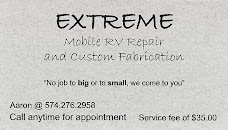Welcome to part 2. Let me reiterate a few important points from the last post. First of all let me say that in now way is your manufacturer responsible for any damage you do to your RV that is caused by lack of knowledge as to how to operate all of the functions. The number of people who call in and want this covered under warranty is unbelievable. Please take the responsibility to make sure you do not drive off of the lot without all of the information necessary. Salespeople as a whole are trained to take control of the transaction and “close the sale”, don’t let them hurry you out of the dealership without a proper walk-through, you are going to be paying for it, so make sure you ask every question you might have. Leave no stone unturned, better safe than sorry.
Now on to the next subject-maintenance of your unit. Another thing in the long list of things you should know is that there are certain things on your RV that you will be responsible for maintaining. Damage, due to lack of maintenance was the 2nd highest in the number of calls we received every day. A leaky roof can do thousands of dollars worth of damage, and oddly enough, most newbies don’t seem to be aware that they are responsible for maintaining the sealant that is laid down around the top of your roof. This sealant, typically a self-leveling variety, tends to expand and contract with the changing of the seasons, especially if the vehicle is not kept indoors when not in use. I recommend checking the sealant at least every six months. More if you live in areas with more severe climates such as extreme heat or cold. Look for holes, bubbles, and the sealant pulling away from the corners where it should be firmly attached. Most RV supply centers will have a replacement sealant that you can use yourself to spot repair any voids. It’s a good idea to have all of the sealant removed and completely replaced every few years though. This is not unlike having to maintain the roof on your house, yet most people don’t seem to understand why it has to be done. It’s also a good idea to keep the roof itself clean. Once the sealant gets dirty and black, it’s not quite as easy to see the voids or bubbles.
There is most likely sealant on other parts of the unit as well, such as compartment doors and windows. Checking those areas on a regular basis can stop water damage before it happens.
It’s always a good idea to read your owner’s manual. It will detail what items are your responsibility to take care of after the purchase of the unit. Many, many people have admitted to me that they did not bother to read it. Once again, any damage or items that are broken due to you not knowing your responsibility will not be covered by the manufacturer’s warranty. Unfortunately, a customer does not look very smart asking for those things to be covered, especially if they have not read their manual or the warranty paperwork they sign at purchase. Reading the fine print will save a lot of headache for you and the customer service rep on the other end of the phone.
If there are things in particular you would like me to cover, please let me know.
Have a great day
Subscribe to:
Post Comments (Atom)

No comments:
Post a Comment